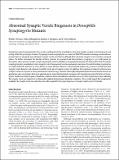Abnormal Synaptic Vesicle Biogenesis in Drosophila Synaptogyrin Mutants
Author(s)
Stevens, Robin Jean; Akbergenova, Yulia; Jorquera, Ramon; Littleton, J. Troy
DownloadStevens-2012-Abnormal Synaptic Ve.pdf (4.003Mb)
PUBLISHER_POLICY
Publisher Policy
Article is made available in accordance with the publisher's policy and may be subject to US copyright law. Please refer to the publisher's site for terms of use.
Terms of use
Metadata
Show full item recordAbstract
Sustained neuronal communication relies on the coordinated activity of multiple proteins that regulate synaptic vesicle biogenesis and cycling within the presynaptic terminal. Synaptogyrin and synaptophysin are conserved MARVEL domain-containing transmembrane proteins that are among the most abundant synaptic vesicle constituents, although their role in the synaptic vesicle cycle has remained elusive. To further investigate the function of these proteins, we generated and characterized a synaptogyrin (gyr)-null mutant in Drosophila, whose genome encodes a single synaptogyrin isoform and lacks a synaptophysin homolog. We demonstrate that Drosophila synaptogyrin plays a modulatory role in synaptic vesicle biogenesis at larval neuromuscular junctions. Drosophila lacking synaptogyrin are viable and fertile and have no overt deficits in motor function. However, ultrastructural analysis of gyr larvae revealed increased synaptic vesicle diameter and enhanced variability in the size of synaptic vesicles. In addition, the resolution of endocytic cisternae into synaptic vesicles in response to strong stimulation is defective in gyr mutants. Electrophysiological analysis demonstrated an increase in quantal size and a concomitant decrease in quantal content, suggesting functional consequences for transmission caused by the loss of synaptogyrin. Furthermore, high-frequency stimulation resulted in increased facilitation and a delay in recovery from synaptic depression, indicating that synaptic vesicle exo-endocytosis is abnormally regulated during intense stimulation conditions. These results suggest that synaptogyrin modulates the synaptic vesicle exo-endocytic cycle and is required for the proper biogenesis of synaptic vesicles at nerve terminals.
Date issued
2012-12Department
Massachusetts Institute of Technology. Department of Biology; Massachusetts Institute of Technology. Department of Brain and Cognitive Sciences; Picower Institute for Learning and MemoryJournal
Journal of Neuroscience
Publisher
Society for Neuroscience
Citation
Stevens, R. J., Y. Akbergenova, R. A. Jorquera, and J. T. Littleton. “Abnormal Synaptic Vesicle Biogenesis in Drosophila Synaptogyrin Mutants.” Journal of Neuroscience 32, no. 50 (December 12, 2012): 18054-18067.
Version: Final published version
ISSN
0270-6474
1529-2401